Massachusetts Water Resources Authority
PRESS RELEASE
Posted:
June 14, 2021
Contact:
Ria Convery
(617) 788-1105, Ria.Convery@mwra.com
Algae at Quabbin Reservoir
|
Starting on June 7th, MWRA staff observed an increase in algae activity in Quabbin Reservoir based on measurements from the water quality monitoring buoy (first deployed last year), which performs measurements of water quality throughout the depth of the reservoir 4 times per day. These measurements allow for an assessment of the algae concentrations, by measurement of chlorophyll a and other parameters. The bloom is being monitored by Department of Conservation and Recreation (DCR) and MWRA staff. Staff are collecting samples in the reservoir, performing microscopic analyses, and identifying and counting the algae concentrations. While the presence of low levels of algae (naturally occurring microscopic plants) is a sign of a healthy reservoir, this particular bloom consists of Chrysosphaerella algae, which may impart a metallic taste to tap water. This is the same algae that was found in 2019 that caused metallic taste complaints across CVA communities. In addition to the in-reservoir monitoring, water quality is monitored continuously with on-line analyzers immediately before and after treatment at the Brutsch Water Treatment Facility, as well as further downstream. MWRA is communicating with each of the Chicopee Valley Aqueduct communities routinely. Chrysosphaerella is a golden brown algae of the Chrysophyte family. More information about the Quabbin Reservoir and water quality is available at MWRA.com. |
### |
Follow us |
Updated
June 14, 2021

